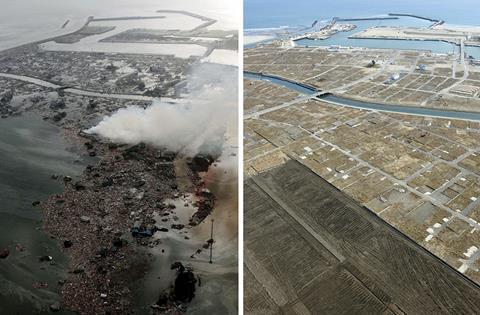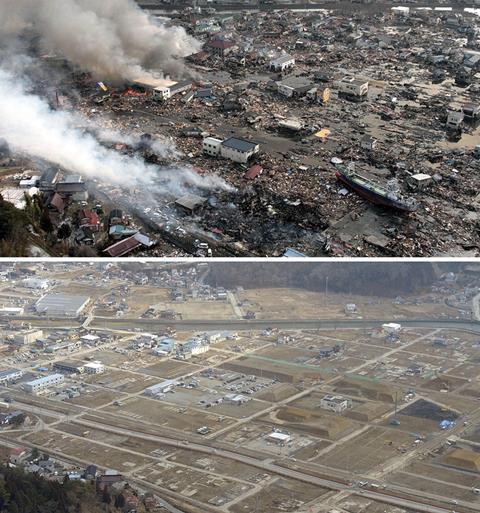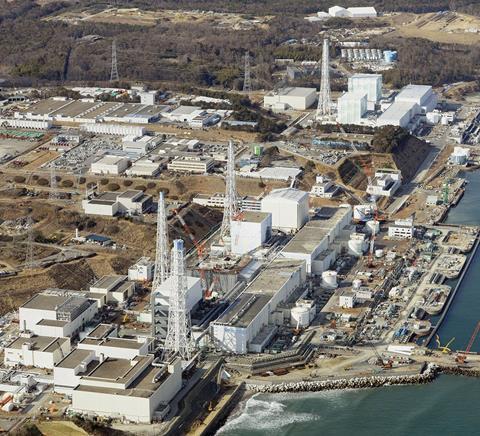Three years on from its devastating earthquake and tsunami, Japan is, for the first time, signalling that it needs help rebuilding homes and communities. For UK construction firms willing to dig in, this could mean new opportunities

Imagine if a giant wave destroyed much of the UK’s eastern coastal cities and villages and that three years later those same communities remained un-rebuilt and victims housed in near- tent-like conditions. An impossible scenario, you’d think, given the UK’s status as an industrious, first world power. However, travel 6,000 miles to the other side of the world and to humankind’s most technologically-able nation, you will find this state of inaction and neglect very much in evidence.
Today more than 270,000 citizens of the world’s third-largest economy - Japan - remain displaced and largely living in subsistence-level accommodation, three years after the earthquake, tsunami and subsequent nuclear meltdown which devastated the country. This temporary housing - of which more than 90% is nearing the end of it lifespan, according to NGO the Recycling Society Promotion Center - is now deteriorating rapidly, while there are still people living in squalid conditions in evacuation centres.
Just over 1,000 out of a planned 29,500 state-built homes had been completed by March this year in the triple-disaster hit region, according to officials. There are a variety of reasons for this. But some of the main culprits - a labour shortage and high labour costs, alongside a need to build capacity ahead of the Tokyo 2020 Olympics - have a famously isolationist Japan talking about letting in foreign construction workers for the first time.
Huge task
Meanwhile, conditions for displaced residents are grim. The last evacuation centre near the stricken Fukushima nuclear plants has become notorious, a place where mainly elderly residents complain of neglect, unheated meals and theft.
“We’ve been abandoned by the authorities. There’s only us old folk; the disabled; about 200 of us left and few of the grandkids,” says 73-year-old former barber Shigemitsu Oikawa from his thin futon bedding lying on a rush-matted floor of a former classroom. The school is still home to evacuees from Futaba, the town that hosted Fukushima Daiichi nuclear power station, years after the Great Tohoku quake.
Oikawa describes his new home just miles from Tokyo as an “ubasute-yama”, literally a granny dump. More than 1,400 evacuees of all ages had originally been moved to the abandoned school in Kazo, Saitama, a month after the Great Tohoku quake struck. Those able to move on since the triple disaster have done so, leaving the more vulnerable to fend for themselves in the shabby school that lacks even a kitchen.
The task at hand is considerable. At least 95,107 buildings have been destroyed, washed away or burnt down, according to official figures. The World Bank estimates the cost of the loss of buildings and infrastructure at £144bn, making it the world’s most expensive disaster. The total cost of the disasters and the clean up would be close to 10% of the country’s current GDP.
Despite the scale of this, the central government said it would pick up the tab for almost all of the rebuilding in the coastal areas of Tohoku, north-eastern Japan, devastated by the earthquake and tsunami of 11 March 2011. The Japanese government has said it will spend about 23 trillion yen (£130bn) on reconstruction between 2011 and 2017 - excluding the cost of decommissioning Fukushima.

But rebuilding the disaster-struck areas has been slow or nonexistent. The town’s mayor, Katsutaka Idogawa, hopes to return to governing abandoned Futaba in 10 years, on the condition radiation levels fall significantly. He says the government policy for victims to return to Fukushima as soon as possible is wrong. Meanwhile, other victims subsist on government handouts in jerry-built temporary housing unfit for the cold winters and sweltering summers. The Recycling Society Promotion Center says more than 300 repair requests are issued each month for just the few thousand homes in the Fukushima prefecture. Their entire living quarters are often no bigger than the average UK kitchen-size.
The reasons behind the paralysis are multiple and complex. First there is the bureaucratic nightmare of dealing with land where no one is sure where property boundaries start and end. Next are the unresolved arguments over where to rebuild their lost communities - near the coast or on higher ground beyond the reach of a future tsunami. No one can agree. So meanwhile the central government is ploughing ahead with huge schemes to line the coast with 20m-high walls of concrete. Critics, who include Akie Abe, the wife of Japan’s prime minister, say the schemes are hugely unpopular with the public and effectively just a way for central government to appease local government by diverting state money their way.
“The rebuilding is a total brain-dead bureaucratic mess, succeeding only in depleting the entire coastline of its population,” says US-born Japanese citizen Steve Yamaguchi, who has a construction business based in Tohoku. So far he has managed to secure a few small-scale rebuilding projects but says little else has been achieved.
Lack of capacity
Then there are the acute labour, materials and machinery shortages in the affected regions and in the construction industry in general in Japan. More than half of construction firms told the land transport and infrastructure ministry in December that they were struggling to secure skilled workers. The conditions are so bad that much of the 19 trillion yen (£110bn) of work tended in 2011 and 2012, about 25%, went unbid for. And some of the money that was spent - roughly 1.3 trillion yen (£7.6bn), was found to have been earmarked for work that has nothing to do with reconstruction of disaster-hit areas.
“Unspent funds allocated by the central government for ‘accelerated’ Tohoku earthquake and tsunami damage reconstruction continue to pile up,” says Darrel Whitten, managing director of Investor Networks Inc based in Tokyo, “ostensibly due to a shortage of prefectural personnel to manage these expenditures, and rising material as well as personnel costs. Only 3% of the needed replacement public housing has been completed in the three prefectures affected.”
This situation seems to be opening opportunities for foreign enterprises for the first time. In the early days of reconstruction it was unrealistic that foreign firms would have a chance winning work in the massive Tohoku build, says Yamaguchi, because of corruption, and protectionism designed to give locals work. But now, Japan’s difficulty could be the UK’s opportunity.
Sue Kinoshita, director of Trade & Investment at the British Embassy in Tokyo, says there is now a “huge amount of business to be won” - but it is not without difficulties for UK firms. “It will be very fragmented, with each local authority working up its own plans for reconstruction. There is a real lack of capacity, with many local governments still preoccupied with immediate clear-up and lacking either the manpower or the skills to fashion orderly blueprints and specifications,” she says.
“Our judgment is that companies that wish to win business are likely to need to develop proposals proactively and put them to local authorities to help them with their thinking. A number of Japanese academics and consultants have already done this.”
British architect Mark Dytham, who has been working in Tokyo for over 20 years and is helping with construction projects in Tohoku, agrees there is work for UK building companies here and says he has never been busier.
“The economy is taking off because of the Olympics. There is a lot of movement in the industry and they have all the work they can handle… even in Tokyo,” he says. “We have some small projects rebuilding in Tohoku working with Pritzker prize-winning architect Toyo Ito, but everything is taking ridiculous amounts of time to get started up there,” he says.

There is no shortage of money thanks to the reconstruction fund that is going begging. The government had to roll over to the next budget 3.8 trillion yen (£22bn) it failed to spend out of the 10 trillion yen (£58bn) earmarked for public works across the whole country - including Tohoku - in the fiscal year to March 2013. It also recently announced new stimulus spending of 5.5 trillion yen, much of it for public works across the country, in a bid to offset any negative adverse effects of a recent increase in a national sales tax. So little of those funds have been taken up by Japan’s construction industry that many here say their under-utilisation explains why the prime minister Shinzo Abe’s stimulus has so far failed to tackle long-term deflation. The announcement that Japan won the 2020 Olympic bid is also shifting builder’s sights away from Tohoku, says Dytham.
Japan’s labour shortage is exacerbated by its unenviable status as the fastest ageing country in the world. By 2060 the number of Japanese will have fallen from 127 million to about 87 million, of which almost 40% will be 65 or older. Naturally this is leading to a dire shortage of manpower for Japan’s construction industry, opening up a debate about the previously unthinkable topic of immigration. Only one out of seven Japanese people support the idea of increased immigration, with around half “absolutely opposed”.
But according to Jeff Graves - who until recently was the only non-Japanese person at a top Japanese management consultancy specialising in real estate and construction - there are other reasons for the lack of bids for works. “Yes, raw materials prices are up. Yes, the workforce is ageing. Yes, not being able to fire someone slows hiring. But none of those is really new,” he says.
We are welcoming foreign investors with open arms. There is no discrimination against firms who meet the conditions
Daisaku Yukita, Invest Japan Department jetro.go.jp
“The largest factor is likely that the government has finally wised up to the importance of hiring project managers to bid out their projects. Bids from about three to four years ago are being let by people who know construction, and therefore how much a project is supposed to cost. The days of collusion and massively inflated profits from government projects are over. The result: many are bowing out from government bids. Big surprise.”
Given the paucity of domestic bidding, Japan is now sending out cautious signals overseas for help, and even has a section on the Japan External Trade Organisation (Jetro) website listing tender procurement opportunities in English (www.jetro.go.jp/en/database/procurement/).
“We are welcoming foreign investors with open arms,” says Daisaku Yukita of the Invest Japan division of Jetro. “There is no discrimination against firms who meet the conditions,” he says.
UK firms will still have to jump through considerable hoops to secure work. They will need a Japanese partner and “need to put the time in to get to know the market,” says Kinoshita, adding that British firms must be willing to commit themselves to entering Japanese in a big way.
“The only major restriction is you must have a track record that matches with the size of the project you bid for. Of course those joining a bid must have entity in Japan. We can help get you started by going to exporttojapan.co.uk. Though UK firms might find bidding for Tokyo 2020 Olympics a more compelling alternative.”
With Arup already securing a major Olympics contract, Kinoshita says it is other consultants including engineers, sustainability consultants and landscape planners that are seeing the biggest opportunities in Japan. But the Tohoku region is known even in Japan for its intractability and isolationism, far from the cosmopolitan openness of Tokyo. She suggests that this adds to the difficulties of taking part in the reconstruction.
“An overseas contractor could not come in as such and get an award. They would need to open a Japanese entity and get it licensed by the land ministry, or buy a Japanese entity that already has a license,” agrees Graves. “There are a number of additional conditions that they (and their bids) would need to meet, but it would be possible. The question for Tohoku is, after all the time and cost of establishing a presence in Japan, would it still be profitable and timely?”
Nuclear future?

Sitting squarely atop of the Pacific Ring of Fire, Japan has long cultivated a nuclear power programme despite the dangers for an earthquake-prone nation. The Fukushima Daiichi meltdown exposed the flaws in such a policy and now the country is paying the price in uncountable ways.
For a start the nation faces a bill of $1- 2.5bn to dismantle the Fukushima plant, and a 40-year wait until it’s safe to decommission. The plant does finally seem to be under some control but remains in a state of high alert. Communities around the stricken plant have yet to return, although radiation levels now are low enough for them to do so.
Meanwhile, the country’s nuclear power stations remain switched off. Expensive imported fossil fuels make up the difference making Japan almost as dirty as China in terms of per capita CO² pollution.
Tightly squeezed by energy needs, Japanese leaders say they are ready to embark again on the nuclear route. CEO and chairman of the Institute of Energy Economics think tank Masakazu Toyoda can’t see how Japan can continue without nuclear power. He suggests in a report Japan should have about a quarter of its energy from nuclear by 2030 for an optimum energy mix. So expect to see a newly nuclear-revamped Japan in the near future.
Meanwhile, renewable energy, though on the increase with some major solar PV schemes, looks likely to remain an afterthought for some time to come.



























No comments yet